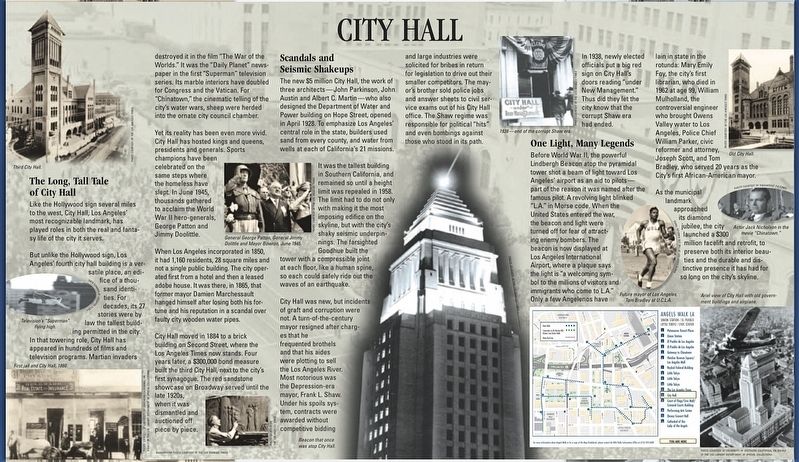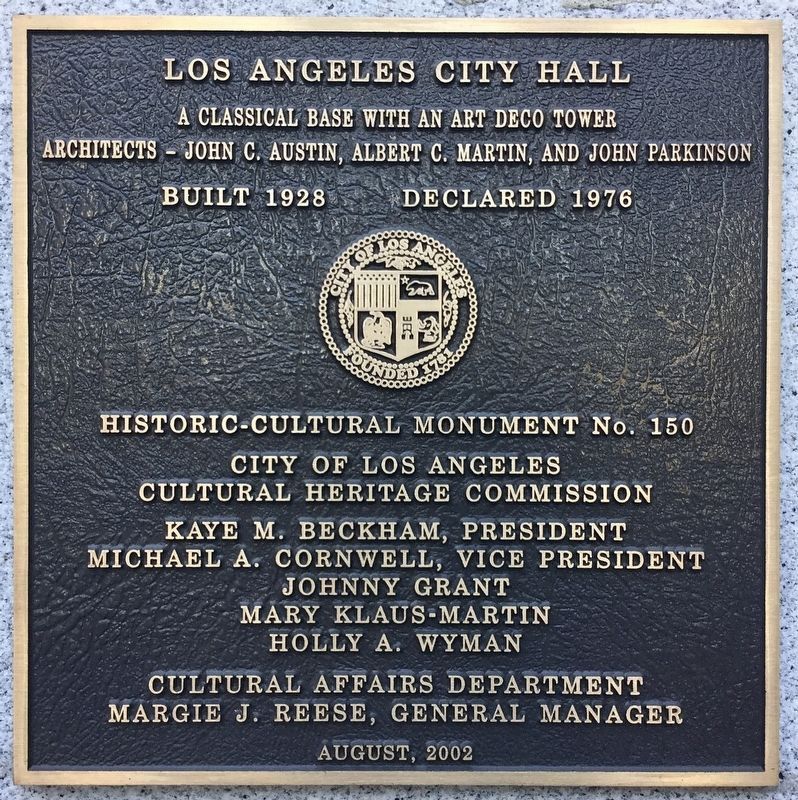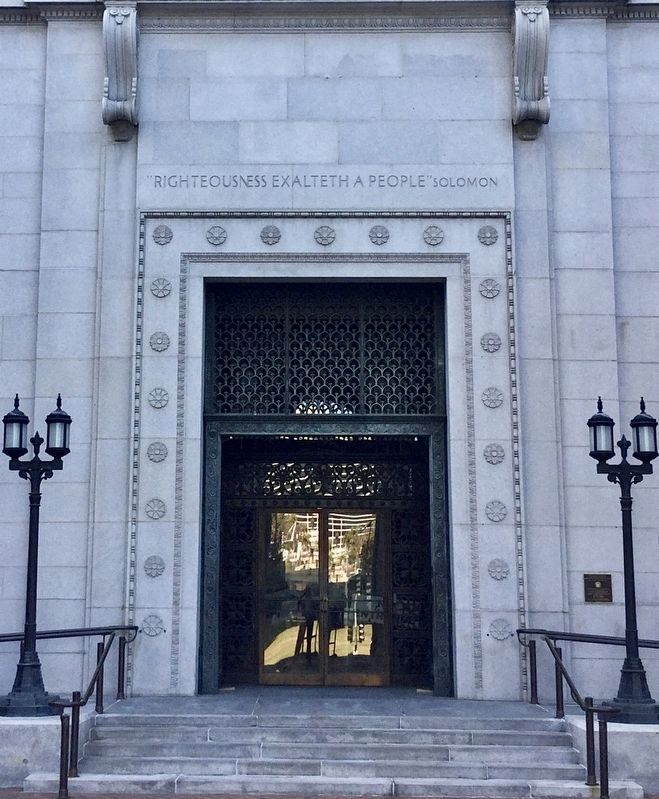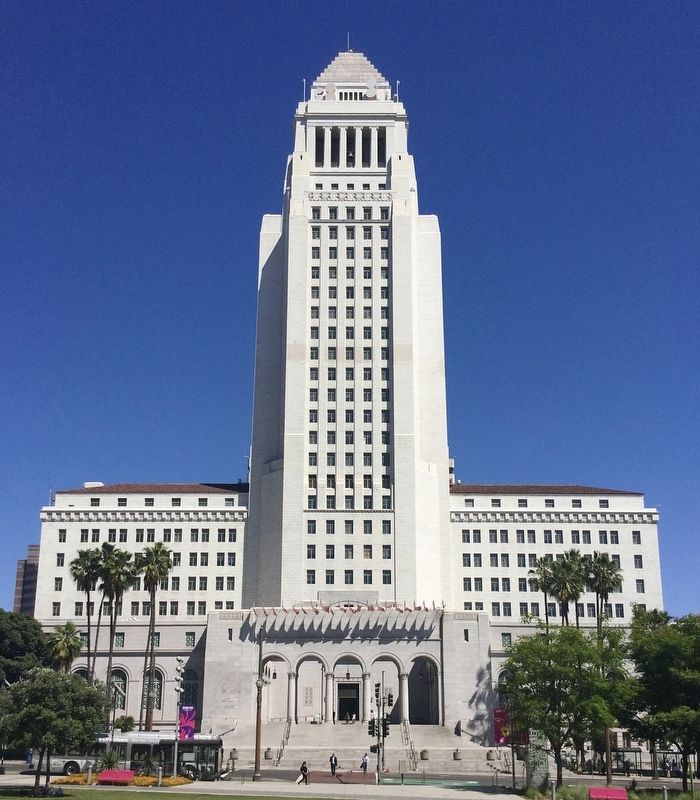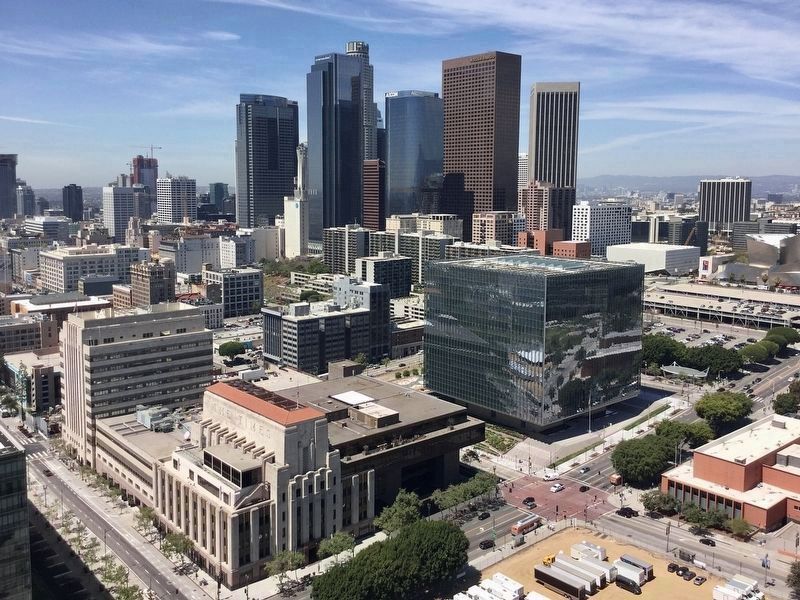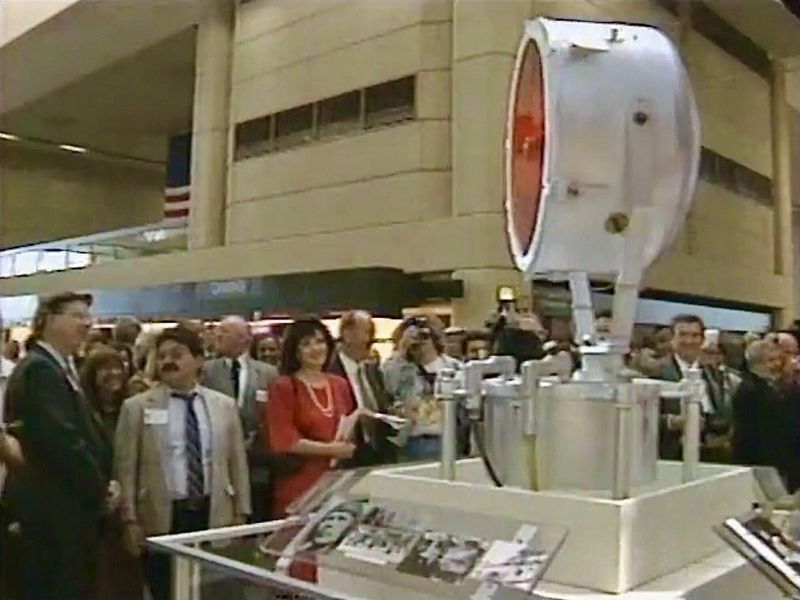Downtown Los Angeles in Los Angeles County, California — The American West (Pacific Coastal)
Los Angeles City Hall
The Long, Tall Tale of City Hall
Like the Hollywood sign several miles to the west, City Hall, Los Angeles' most recognizable landmark, has played roles in both the real and fantasy life of the city it serves.
But unlike the Hollywood sign, Los Angeles' fourth city hall building is a versatile place, an edifice of a thousand identities. For decades, its 27 stories were by law the tallest building permitted in the city. In that towering role, City Hall has appeared in hundreds of films and television programs. Martian invaders destroyed it in the film "The War of the Worlds." It was the "Daily Planet" newspaper in the first "Superman" television series. Its marble interiors have doubled for Congress and the Vatican. For "Chinatown," the cinematic telling of the city's water wars, sheep were herded into the ornate city council chamber.
Yet its reality has been even more vivid. City Hall has hosted kings and queens, presidents and generals. Sports champions have been celebrated on the same steps where the homeless have slept. In June 1945, thousands gathered to acclaim the World War II hero-generals, George Patton and Jimmy Doolittle.
When Los Angeles incorporated in 1850, it had 1,160 residents, 28 square miles and not a single public building. The city operated first from a hotel and then a leased adobe house. It was there, in 1865, that former mayor Damien Marchessault hanged himself after losing both his fortune and his reputation in a scandal over faulty city wooden water pipes.
City Hall moved in 1884 to a brick building on Second Street, where the Los Angeles Times now stands. Four years later, a S300,000 bond measure built the third City Hall, next to the city's first synagogue. The red sandstone showcase on Broadway served until the late 1920s, when it was dismantled and auctioned off piece by piece.
Scandals and Seismic Shakeups
The new $5 million City Hall, the work of three architects — John Parkinson, John Austin and Albert C. Martin — who also designed the Department of Water and Power building on Hope Street, opened in April 1928. To emphasize Los Angeles' central role in the state, builders used sand from every county, and water from wells at each of California's 21 missions.
It was the tallest building in Southern California, and remained so until a height limit was repealed in 1958. The limit had to do not only with making it the most imposing edifice on the skyline, but with the city's shaky seismic underpinnings. The farsighted Goodhue built the tower with a compressible joint at each floor, like a human spine, so each could safely ride out the waves of an earthquake.
City
Hall was new, but incidents of graft and corruption were not. A turn-of-the-century mayor resigned after charges that he frequented brothels and that his aides were plotting to sell the Los Angeles River. Most notorious was the Depression-era mayor, Frank L Shaw. Under his spoils system, contracts were awarded without competitive bidding
and large industries were solicited for bribes in return for legislation to drive out their smaller competitors. The mayor's brother sold police jobs and answer sheets to civil service exams out of his City Hall office. The Shaw regime was responsible for political "hits" and even bombings against those who stood in its path.
In 1938, newly elected officials put a big red sign on City Hall's doors reading "under New Management." Thus did they let the city know that the corrupt Shaw era had ended.
One Light, Many Legends
Before World War II, the powerful Lindbergh Beacon atop the pyramidal tower shot a beam of light toward Los Angeles' airport as an aid to pilots — part of the reason it was named after the famous pilot. A revolving light blinked "L.A." in Morse code. When the United States entered the war, the beacon and light were turned off for fear of attracting enemy bombers. The beacon [was] displayed at Los Angeles International Airport, where a plaque said the light is "a welcoming symbol to the
millions of visitors and immigrants who come to L.A."
Only a few Angelenos have lain in state in the rotunda: Mary Emily Foy, the city's first librarian, who died in 1962 at age 99, William Mulholland, the controversial engineer who brought Owens Valley water to Los Angeles, Police Chief William Parker, civic reformer and attorney Joseph Scott, and Tom Bradley, who served 20 years as the City's first African-American mayor.
As the municipal landmark approached its diamond jubilee, the city launched a $300 million facelift and retrofit, to preserve both its interior beauties and the durable and distinctive presence it has had for so long on the city's skyline.
Erected 2000 by City of Los Angeles. (Marker Number 150.)
Topics and series. This historical marker is listed in these topic lists: Architecture • Government & Politics • Settlements & Settlers. In addition, it is included in the Los Angeles Historic-Cultural Monument series list. A significant historical year for this entry is 1928.
Location. 34° 3.245′ N, 118° 14.603′ W. Marker is in Los Angeles, California, in Los Angeles County. It is in Downtown Los Angeles. Marker is on Spring Street south of Temple Street, on the left when traveling south. Touch for map. Marker is at or near this postal address: 200 N Spring St, Los Angeles CA 90012, United States of America. Touch for directions.
Other nearby markers. At least 8 other markers are within walking distance of this marker. The Lindbergh Beacon (a few steps from this marker); a different marker also named Los Angeles City Hall (about 400 feet away, measured in a direct line); Fletcher Bowron Square (about 500 feet away); Vietnam Memorial (about 600 feet away); Los Angeles Times (about 600 feet away); United States Court House (about 700 feet away); Los Angeles Star (about 700 feet away); Bella Union Hotel Site (about 700 feet away). Touch for a list and map of all markers in Los Angeles.
More about this marker. The interpretive sign has been removed, and has not yet been replaced.
Regarding Los Angeles City Hall. The beacon once displayed at Los Angeles International Airport is now back on top of City Hall — see Other Nearby Markers.
Also see . . . Angels Walk L.A. Self-guided walking tours of historic neighborhoods in Los Angeles. The City Hall marker is part of the Union Station walk. (Submitted on June 27, 2023.)
Credits. This page was last revised on January 5, 2024. It was originally submitted on June 27, 2023, by Craig Baker of Sylmar, California. This page has been viewed 147 times since then and 50 times this year. Photos: 1, 2, 3, 4, 5. submitted on June 27, 2023, by Craig Baker of Sylmar, California. 6. submitted on January 5, 2024, by Craig Baker of Sylmar, California.
